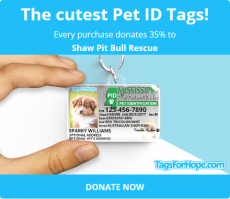Acute Moist Dermatitis (Hot Spots)
"This disorder is caused by self induced trauma as the patient bites, rubs, or scratches at a part of its body in an attempt to alleviate some pain or itch. The majority of cases are complications
of flea bite hypersensitivity, but allergic skin diseases, other ectoparasites, anal sac problems, inflammations such as otitis externa (inflamed ears), foreign bodies in the coat, irritant
substances, dirty unkempt coats, psychoses and painful musculoskeletal disorders may be underlying causes. Owners usually believe that some factor producing a diet that is too rich may create the
problem, but only a severe, essential fatty acid deficiency has been shown to be a cause. These factors initiate the itch-scratch cycle. The intense trauma produces sever large lesions in a few
hours. Animal particularly disposed to this problems are those with a heavy coat that has a dense undercoat, such as Golden and Labrador Retrievers, German Shepherds, Collies and St. Bernards. The
problem is much more common in hot humid weather and may have something to do with lack of ventilation in the coat. A typical lesion is red, moist and oozing. There is a crust of proteinaceous
exudate in the center of the area surrounded by a halo of red skin. The hair is lost from the area, but the margins are sharply defined from the surrounding normal skin and hair. The lesion
progresses rapidly if appropriate therapy is not started at once. Much pain is associated with the local area, and this may eventually deter the animal from further trauma. Lesions are often located
in close proximity to the primary painful process, i.e., near infected ears, anal sacs and flea bites on the rump.
A study of the type of bacteria found in lesions of pyotraumatic dermatitis reveals multiple organisms, with Staphyloccus intermedius being the most common. It also showed that the St. Bernard and
Golden Retriever dogs tended to have a deeper pus producing infection. Diagnosis is made by the history of acute onset, the physical appearance, and the association with a more or less primary cause.
If the condition is persistent or recurrent, consider bacterial hair follicle inflammation, fungal infections, demodex infections, yeast infections or neoplasia (lymphosarcoma or sweat gland
carcinoma) as differential diagnoses. True pyotraumatic dermatitis is a relatively flat, eroded to ulcerated lesion. Lesions that are thickened. plaque like and bordered by papules (bumps) and or
pustules should always suggest a primary eruptive process, especially a staphylococcal infection.
Therapy is effective if applied promptly and vigorously. Sedation or anesthesia is usually needed to allow thorough cleansing of the area. Cleansing is the first and most important step in local
therapy. The hair is clipped away from the lesion and the skin is thoroughly cleaned with a mild antiseptic solution or scrub such as povidone-iodine. A single application of 5% tannic acid and 5%
salicylic acid in 70% alcohol is used as an astringent. This can be followed by wet soaks with 5% aluminum acetate (Domeboro solution) applied three or four times daily for 10 minutes each time. This
action is drying, astringent and antiseptic. Topical application of antibiotic cream three times daily is useful. Five days of systemic corticosteroids in anti-inflammatory doses (prednisolone 1.1
mg/kg SID) is useful in alleviating the pruritis, pain and local inflammation. As the lesion becomes dry and crusted, topical medication should be changed to softening creams and emollients. At the
time of the initial treatment, it is most important to find the predisposing factor and eliminate or modify it to stop the patient's reflex self-trauma. The treatment to accomplish this varies,
depending on the primary cause.
Clients always clamor for ways to prevent future lesions, since some unfortunate dogs may have repeated problems. There is no simple means of prevention. However, constant attention to grooming,
hygiene, baths and parasite control and periodic cleaning of the ears and anal sacs will help. Owners should be particularly vigilant during periods of hot, humid weather. Although diet is often
suggested as a cause, except for severe fatty acid deficiency or food hypersensitivity this has never been proven."
The above article was taken from "Small Animal Dermatology, Fourth edition and was authored by Muller, Kirk and Scott.
Following are a number of hot spot remedies which have been successfully used. These remedies were all submitted by various members of the Golden-L list.
Shave the hair from the area and apply hydrogen peroxide (first time only; H2O2 will kill new cells as well as bacteria and other nasties), then Sulfodene, an amber liquid that smells yucky. Apply
the Sulfodene twice a day until the hot spot heals. Put the dog in an E-collar (I call it an Easter bonnet) to keep the dog from licking or biting at the sore.
Brew a regular Lipton tea bag in about 3 ounces of water in the Microwave for about 10 minutes. Take the teabag and when it is still very warm but not hot enough to burn, apply it to the hot spot.
Keep applying the tea bag for about 15 minutes, Repeat application about 4 or 5 times a day. The warmth of the tea bag soothes the pain. After the second application, there was an indication of the
drying effect of the tannic acid in the tea. The principle behind this is the combined warmth and the drying agent of the tannic acid in the tea leaves.
Tea Tree Oil (or Melaleuca Oil) is GREAT stuff. I use it for hot spots and for a million things on humans as well. It is antibacterial, antifungal, penetrates below the surface of the skin, soothes
the skin (try it on a burn-it's great) taking the pain/itch away instantly, is slightly drying(great for hot spots) and TASTES AWFUL. I haven't found a dog that will lick a spot with Melaleuca oil on
it yet.
There is a product put out by Farnham Labs. called Blue Lotion Wound Dressing and Antiseptic and is used for treatment of sores on horses. If you catch the hot spot in its early stages when it is
still smaller than a dime, application of Blue Lotion three times a day will usually have it dried up in two days and scabbed over. Anything bigger than this requires something else.
Here's my favorite hot spot remedy. I clip off the hair, clean the area with peroxide, and then spray on Terra Cortril spray, available from Foster & Smith. That spray will usually clear it up in
a couple of days. Also, at least for my guys, it must not taste very palatable, because they never try to lick the area once I spray it on.
I've had good luck packing the hot spot with Gold Bond Powder, provided it's a small hot spot and I've caught it early.
I have three goldens and live in South Florida. With our heat and humidity we are hot spot experts. 'Mineral Ice' works very well to dry them up within a day or two. In many cases they are dry
overnight. It does help to trim the fur first to air it out and get better coverage.
I've been told to clip the fur and apply a solution of betadine and water to the area once a day. This has worked successfully with my current foster dog who has extensive hot spots on his back and
stomach. He is also on antibiotics.
For hot spots I like the Gentocin spray. I also trim the hair around it. If I catch it soon enough, Gentocin also seems to help the rather frequent outbreaks of Staph on her belly (allergy-related).
It has saved us from putting her on systemic antibiotics this winter while we have been giving her allergy shots.
Shave the affected area so the air can get at it, clean it with peroxide and then use a topical antibiotic powder such as Eye and Wound Powder. Still another treatment I've heard of is to put Desenex
foot powder on the hot spot. Sounds crazy but Desenex is a zinc based compound and has good drying properties. Sounds to me like it would be good for small spots but when we get to the large ones the
itch drives the poor dog crazy and good old Cortisone comes to the rescue to relieve the itch and then I would get my vet to prescribe.
One last suggestion is to give the hot spot a thorough cleaning , remove the hair from around it and apply Nu-Skin to it.
To summarize all of the suggestions, first isolate the spot by removing the hair, clean it thoroughly with hydrogen peroxide, and apply the treatment of choice - Gentocin spray, Terr- Cotril, or
whatever. The treatment should ideally contain antibiotic and a drying agent. For severe hot spots cortisone is recommended to remove the severe itching.
Reprinted













